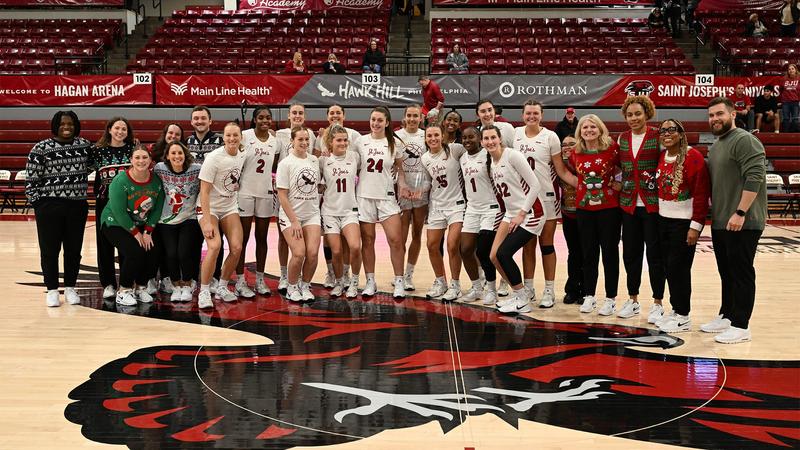SAVANNAH, Ga. – Craig Needham snapped a 2-2 tie early in the third period, Hudson Elynuik scored a pair of goals, and Cam Johnson stopped 37 straight shots – including 19 in the third period – as the Florida Everblades…
Blog
-

Gators Home Winning Streak Comes to an End in 74-67 Loss to Tulsa
GAINESVILLE, Fla. — The Florida Women’s Basketball Team erased a 13-point fourth quarter deficit Sunday afternoon, but they couldn’t quite close it out as Tulsa (8-4) finished the game on an 8-0 run. The loss dropped the Gators to 11-3 on the…Continue Reading
-

Leveling the playing field – MCC Foundation extends SESF partnership
The Melbourne Cricket Club Foundation has renewed its partnership with the Sports Excellence Scholarship Fund (SESF) for a further three years, reaffirming a shared commitment to supporting the next generation of sporting…
Continue Reading
-

Hofstra Wins Fourth Straight With Victory Over Quinnipiac

Ukrainian and European officials had ‘productive’ talks on ending war, US envoy says | Trump administration
A White House envoy said on Sunday he held “productive and constructive” talks in Florida with Ukrainian and European representatives to end the nearly four-year war between Russia and Ukraine.
Posting on social media, Steve Witkoff said the…
Continue Reading

Samsung To Host Series of Tech Forums at CES 2026 – Samsung Global Newsroom
Samsung Electronics today announced that it will host a series of four moderated Tech Forum panel discussions at CES 2026, to highlight industry trends and unveil its distinct AI vision and strategy.
Samsung’s Tech Forums will be held Jan. 5–6 at Samsung’s dedicated exhibition space in the Latour Ballroom at the Wynn Las Vegas. The company will host a total of four moderated panels covering AI, Home Appliances, Services and Design. Samsung executives along with partners, academics, media and industry analysts will participate in each session by topic:
- When Everything Clicks: How Open Ecosystems Deliver Impactful AI (Jan. 5, 9:00 AM) — Yoonho Choi, Digital Appliances Business, Samsung Electronics (Chair, Home Connectivity Alliance)
Description: Collaborating smart home innovators hold an open discussion on the necessity of cross-industry partnership and what it takes for meaningful smart home technology to be woven into daily living.
- In Tech We Trust? Rethinking Security & Privacy in the AI Age (Jan. 5, 2:00 PM) — Shin Baik, Group Head, AI Platform Center, Samsung Electronics
Description: Experts in security and AI examine the science of trust and how transparency and secure systems can spark a meaningful change for AI adoption.
- FAST Forward: How Streaming’s Next Wave is Redefining Television (Jan. 5, 4:00 PM) —
Salek Brodsky, Executive Vice President, Visual Display Business, Samsung Electronics
Description: Leaders in TV and entertainment explore the next wave of streaming, including free ad-supported streaming television (FAST), hybrid models and creator-led channels to shape a more interactive future.
- The Human Side of Tech: Designing a Future Worth Loving (Jan. 6, 1:00 PM) — Mauro Porcini, President and Chief Design Officer, DX Division, Samsung Electronics
Description: Design leaders urge the tech industry to look beyond minimalist, spec-driven approaches toward more expressive, human-centered design shaped by new materials, AI and creativity.
In covering the latest trends in technology and daily living, the Technology Forum discussions will serve as a complement to the company’s latest product innovations, which will be showcased at the Samsung Exhibition Zone at the Wynn from Jan. 5–7.
Continue Reading

Couple lose home loan complaint in face of $50,000 break fee
The main banks are now advertising rates of 4.49 percent for 12 months.
Photo: RNZA couple who regretted their decision to fix their home loan for five years in 2023 have been unsuccessful in their complaint against their bank.
They complained to the Banking Ombudsman, which issued a case note on its decision this month.
It said the couple fixed their home loan for one year in 2021 and 2022. But in 2023, they refixed at the lowest rate available, which was for five years.
Reserve Bank data shows that through 2023, the average special five-year rate was between 6.29 percent and 6.66 percent.
This year, they contacted the bank to ask about breaking their fixed term.
The main banks are now advertising rates of 4.49 percent for 12 months.
The couple said the bank had misled and pressured them into refixing the loan for five years.
The woman said she relied on advice from bank staff and wanted the bank to waive the cost of breaking the fixed term, which had been estimated at $45,000 to $50,000.
The ombudsman scheme said it reviewed the correspondence the couple had with the bank,
“There was no evidence bank staff pressured [her] when they refixed in 2021 and 2022. In 2021, [she] chose to fix for one year at the lowest available rate after being offered hardship assistance, which she declined. In 2022, both customers again chose a one-year term at the lowest rate.
“In 2023, [the customer] requested a home loan review session with a senior business manager. [She] recalled the manager saying interest rates were likely to rise, and said she relied on this advice when choosing to fix for five years. The bank did not record the conference call with her, although the manager shared the standard bank disclosures with her, and the manager’s follow-up email summarised the scenarios discussed and interest rate options. The email did not contain any advice or suggestion to fix for a five-year term.”
The ombudsman noted the woman asked about the five-year rate and accepted it, along with a $3000 loyalty payment, which required her to stay with the bank for at least three years.
“[She] was given time, options and accurate written information before she made the decision. We found no evidence of pressure or misleading conduct by the bank.
“We also considered whether the bank properly disclosed early repayment charges. The original loan agreement and subsequent variation letters explained how these charges were calculated and noted that such charges ‘could be large’. The bank met its obligations under the Credit Contracts and Consumer Finance Act 2003.”
The complaint was not upheld.
Mortgage adviser Jeremy Andrews, of Key Mortgages said he did not see many cases like this.
“I did have a case last month where a client had fixed his loan in for five years with his bank directly at 6.39 percent. He didn’t receive any specific advice from the bank that there’s a was good chance of rates dropping over the next five years, and if they did, he could be looking at significant early payment penalties or break fees.
“He was horrified to find out how much the break fees were, even for a small mortgage with just over three years remaining, well into five figures of fees.
“Once we had his break fees on his mortgage, we ran figures through our break cost benefit calculator. Whilst his fees were substantial, it was looking in his favour at the time to pay the break fee to move onto lower rates at the most similar remaining term.”
He said it was part of a mortgage adviser’s job to check clients’ goals and help structure their mortgage to achieve them.
“We discuss the risks and costs of break fees, to confirm understanding before fixing in long term, and potential implications if there’s reasons they might want to restructure or break their fixed rate in future.”
Longer terms we restarting to become more popular again, he said.
Sign up for Money with Susan Edmunds, a weekly newsletter covering all the things that affect how we make, spend and invest money
Continue Reading



